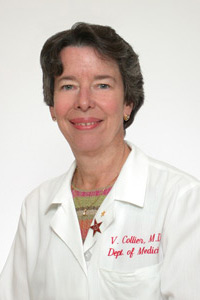Multidisciplinary team focuses on improving discharge process


To create a new paradigm, a multidisciplinary team is at work developing a pilot for an improved discharge process that will relieve the burden on health care providers, patients and their families.Discharging patients safely from the hospital can be a complex process, especially when patients take multiple medications.
“This started off being about medication reconciliation,” said Virginia U. Collier, M.D., MACP, Hugh R. Sharp Jr. Chair of Medicine and executive steer on the project committee. “It’s a complex process, especially when patients are leaving the hospital with a list of medications that may be very different than what they came in on.”
There are three levers in the initiative: people, process and technology.
“The people component is essential. Technology doesn’t help and the workflow doesn’t improve if you don’t have buy-in from all members of the team,” Dr. Collier said.
The project has adopted the approach: “discharge begins upon admission.” That means the entire team — doctors, nurses, case managers, social workers, pharmacists and pharmacy technicians — work together throughout the patient’s stay to prepare the patient for discharge.
“We want the patient to be in the hospital as long as we are providing value to the patient — but not a minute longer,” Dr. Collier said.
Pharmacy plays a key role.
“An accurate medication history with ongoing reconciliation throughout the hospital stay reduces the risk of medication errors and preventable adverse events,” said Terri Corbo, Pharm.D., BCPS, FASHP, vice president, Pharmacy Services. “An accurate history and reconciliation also can tip off the care team to medication-related clinical symptoms.”
Certified pharmacy technicians will be positioned to capture accurate medication histories on high-risk patients soon after the decision to admit. Making this information available to providers early in the admission process sets the foundation for better outcomes.
Floor-based pharmacists, already positioned to provide patient-specific recommendations on medication therapies, will expand their focus to include documenting medication reconciliation recommendations for providers to consider before high-risk patients are discharged.
We are absolutely committed to creating a discharge process that is more efficient and effective for our patients, for our physicians and for other care providers.
“Discharge is discussed on a daily basis,” Clayton said. “There will be a checklist for the day before discharge.” An electronic module for case managers with the patient’s expected length of stay will help to establish benchmarks for discharge.The new model includes an emphasis on interdisciplinary rounding, said Lisa Clayton, BSN, RN, MBA, program manager, Department of Medicine, and the project manager.
“If the patient has pneumonia and the expected length of stay is three days, but the physician determines the patient needs more care, the team can make that adjustment,” she said.
Goals for the improved discharge process include:
- Reduced length of stay for patients in both observation and inpatient status.
- Increased provider satisfaction through more efficient discharge planning and recommendations from Pharmacy for high-risk patients.
- Improved efficiency throughout the hospital stay.
- Increased satisfaction for patients, who will have the education they need to safely go home.
- Increase in medication histories collected by pharmacy technicians.
Specific metrics for those goals will be established as work on the pilot progresses. The plan calls for the initiative to be rolled out in several departments before it is launched throughout the health system.